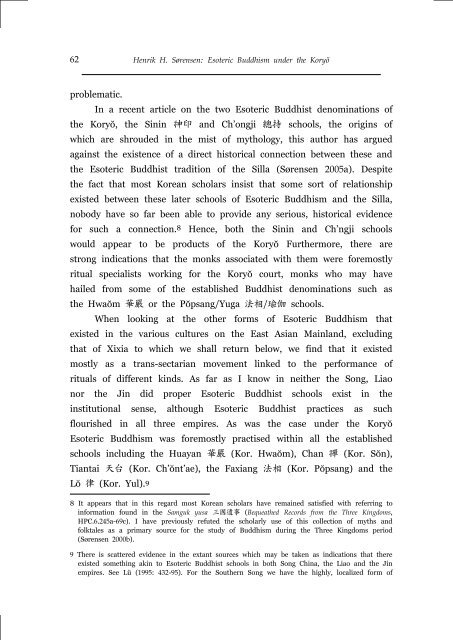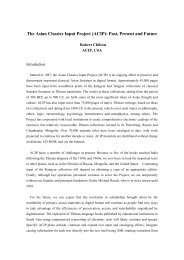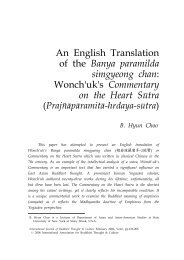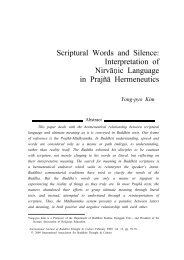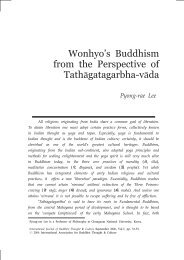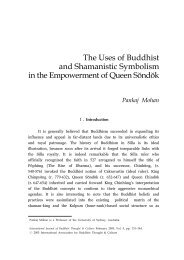Esoteric Buddhism under the KoryÅ in the Light of ... - Buddhism.org
Esoteric Buddhism under the KoryÅ in the Light of ... - Buddhism.org
Esoteric Buddhism under the KoryÅ in the Light of ... - Buddhism.org
Create successful ePaper yourself
Turn your PDF publications into a flip-book with our unique Google optimized e-Paper software.
62<br />
Henrik H. Sørensen: <strong>Esoteric</strong> <strong>Buddhism</strong> <strong>under</strong> <strong>the</strong> Koryŏ<br />
problematic.<br />
In a recent article on <strong>the</strong> two <strong>Esoteric</strong> Buddhist denom<strong>in</strong>ations <strong>of</strong><br />
<strong>the</strong> Koryŏ, <strong>the</strong> S<strong>in</strong><strong>in</strong> 神 印 and Ch’ongji 總 持 schools, <strong>the</strong> orig<strong>in</strong>s <strong>of</strong><br />
which are shrouded <strong>in</strong> <strong>the</strong> mist <strong>of</strong> mythology, this author has argued<br />
aga<strong>in</strong>st <strong>the</strong> existence <strong>of</strong> a direct historical connection between <strong>the</strong>se and<br />
<strong>the</strong> <strong>Esoteric</strong> Buddhist tradition <strong>of</strong> <strong>the</strong> Silla (Sørensen 2005a). Despite<br />
<strong>the</strong> fact that most Korean scholars <strong>in</strong>sist that some sort <strong>of</strong> relationship<br />
existed between <strong>the</strong>se later schools <strong>of</strong> <strong>Esoteric</strong> <strong>Buddhism</strong> and <strong>the</strong> Silla,<br />
nobody have so far been able to provide any serious, historical evidence<br />
for such a connection. 8 Hence, both <strong>the</strong> S<strong>in</strong><strong>in</strong> and Ch’ngji schools<br />
would appear to be products <strong>of</strong> <strong>the</strong> Koryŏ Fur<strong>the</strong>rmore, <strong>the</strong>re are<br />
strong <strong>in</strong>dications that <strong>the</strong> monks associated with <strong>the</strong>m were foremostly<br />
ritual specialists work<strong>in</strong>g for <strong>the</strong> Koryŏ court, monks who may have<br />
hailed from some <strong>of</strong> <strong>the</strong> established Buddhist denom<strong>in</strong>ations such as<br />
<strong>the</strong> Hwaŏm 華 嚴 or <strong>the</strong> Pŏpsang/Yuga 法 相 / 瑜 伽 schools.<br />
When look<strong>in</strong>g at <strong>the</strong> o<strong>the</strong>r forms <strong>of</strong> <strong>Esoteric</strong> <strong>Buddhism</strong> that<br />
existed <strong>in</strong> <strong>the</strong> various cultures on <strong>the</strong> East Asian Ma<strong>in</strong>land, exclud<strong>in</strong>g<br />
that <strong>of</strong> Xixia to which we shall return below, we f<strong>in</strong>d that it existed<br />
mostly as a trans-sectarian movement l<strong>in</strong>ked to <strong>the</strong> performance <strong>of</strong><br />
rituals <strong>of</strong> different k<strong>in</strong>ds. As far as I know <strong>in</strong> nei<strong>the</strong>r <strong>the</strong> Song, Liao<br />
nor <strong>the</strong> J<strong>in</strong> did proper <strong>Esoteric</strong> Buddhist schools exist <strong>in</strong> <strong>the</strong><br />
<strong>in</strong>stitutional sense, although <strong>Esoteric</strong> Buddhist practices as such<br />
flourished <strong>in</strong> all three empires. As was <strong>the</strong> case <strong>under</strong> <strong>the</strong> Koryŏ<br />
<strong>Esoteric</strong> <strong>Buddhism</strong> was foremostly practised with<strong>in</strong> all <strong>the</strong> established<br />
schools <strong>in</strong>clud<strong>in</strong>g <strong>the</strong> Huayan 華 嚴 (Kor. Hwaŏm), Chan 禪 (Kor. Sŏn),<br />
Tiantai 天 台 (Kor. Ch’ŏnt’ae), <strong>the</strong> Faxiang 法 相 (Kor. Pŏpsang) and <strong>the</strong><br />
Lŏ 律 (Kor. Yul). 9<br />
8 It appears that <strong>in</strong> this regard most Korean scholars have rema<strong>in</strong>ed satisfied with referr<strong>in</strong>g to<br />
<strong>in</strong>formation found <strong>in</strong> <strong>the</strong> Samguk yusa 三 國 遺 事 (Bequea<strong>the</strong>d Records from <strong>the</strong> Three K<strong>in</strong>gdoms,<br />
HPC.6.245a-69c). I have previously refuted <strong>the</strong> scholarly use <strong>of</strong> this collection <strong>of</strong> myths and<br />
folktales as a primary source for <strong>the</strong> study <strong>of</strong> <strong>Buddhism</strong> dur<strong>in</strong>g <strong>the</strong> Three K<strong>in</strong>gdoms period<br />
(Sørensen 2000b).<br />
9 There is scattered evidence <strong>in</strong> <strong>the</strong> extant sources which may be taken as <strong>in</strong>dications that <strong>the</strong>re<br />
existed someth<strong>in</strong>g ak<strong>in</strong> to <strong>Esoteric</strong> Buddhist schools <strong>in</strong> both Song Ch<strong>in</strong>a, <strong>the</strong> Liao and <strong>the</strong> J<strong>in</strong><br />
empires. See Lü (1995: 432-95). For <strong>the</strong> Sou<strong>the</strong>rn Song we have <strong>the</strong> highly, localized form <strong>of</strong>


